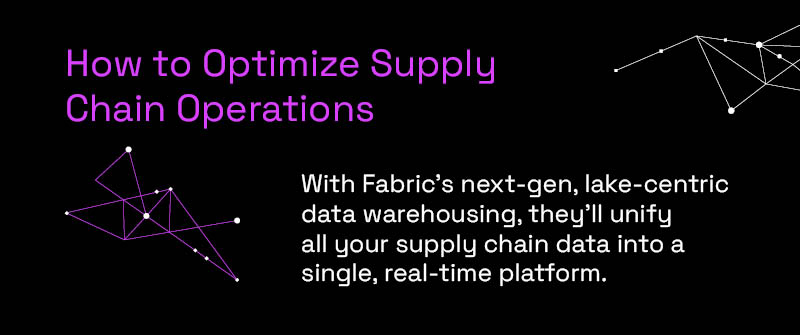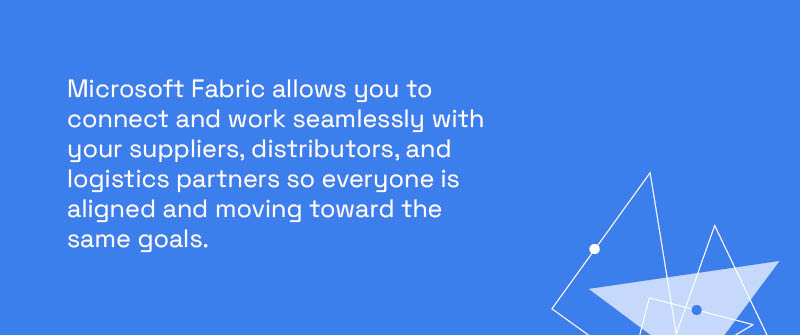
How to Improve Logistics and Supply Chain Management
As you know, keeping your supply chain running smoothly is no small task. From tracking shipments to predicting demands, dealing with delays or unexpected disruptions to juggling suppliers, everything can be quickly thrown off balance. That’s where Microsoft Fabric comes in. Bringing together all your logistics and supply chain data into one powerful platform makes it easy to spot inefficiencies, optimize routes, and keep operations running smoothly. Microsoft Fabric has the potential to transform your supply chain optimization.
Whatever your logistics management challenges may be, Microsoft Fabric consulting firms can come in and integrate Fabric to meet your needs. The right setup will empower your organization with fewer bottlenecks, improved data driven decision making, and a supply chain that runs like a well-oiled machine. Let’s dig deeper!
Seamless Data Integration and Real-Time Data Analytics
Managing a supply chain is like keeping a thousand-piece puzzle together while the pieces keep moving. Tons of data are coming in from everywhere, including suppliers, warehouses, and transportation networks. And if it’s scattered across different systems, making sense of all that data can be a nightmare. A Microsoft Fabric consultant will set up Fabric to integrate your data to eliminate silos so you’ll get a complete, real time visibility of your operations. Thanks to built-in connectors to various data sources, Fabric can seamlessly pull in, transform, and analyze data in real time (and in one place).
Of course, having your data centralized is just the start. The magic happens with Microsoft Fabric’s real-time data analytics, so you can see what’s happening right now and what’s likely to happen next. Here’s how a consultant will leverage real-time data analytics to transform your business:
- Instant Visibility – Get a real-time, end-to-end view of your supply chain, from raw materials to final delivery, all in one place. You can spot and fix issues before they become major disruptions.
- Smarter Demand Forecasting – Fabric can empower you to better predict demand by analyzing historical data and real-time inputs for more accurate demand forecasting.
- Optimize Inventory Levels – Get real-time alerts on stock levels, reduce holding costs, and make sure you always know where products are.
- Proactive Risk Management – Fabric can help you flag potential risks early by allowing the analysis of data from multiple sources so you can act fast and avoid costly delays.
- One Source of Truth – Say goodbye to scattered data. Fabric can create a single hub for all your supply chain info, making decision-making faster and easier.
- Streamlined Communication – When your data lives in one place, everyone from suppliers to warehouse managers are on the same page. Stakeholders can access up-to-date info, track shipments, and quickly respond to issues. Automated alerts and AI-driven analytics flag potential disruptions early so teams can collaborate proactively vs. dealing with fixing last-minute problems.
You won’t just be reacting to supply chain challenges, you’ll be staying ahead of them. Real-time analytics help map the best delivery routes by factoring in traffic and weather, saving time and fuel. Fleet managers can track vehicles in real time, reducing delays and keeping everything running smoothly. Plus, with better delivery management, orders get where they need to be on time, keeping customers happy and aligned with customer preferences.
How to Optimize Supply Chain Operations
Let’s be honest: supply chain and logistics management is a ton to juggle and could very well be what keeps managers up at night. There’s inventory to track, logistics to optimize, and unexpected disruptions to navigate. Microsoft Fabric features take a lot of that stress off your plate by making your supply chain operations smarter and more efficient. Bring in a Microsoft Fabric consultant, and they’ll partner with you to make the most of Fabric’s capabilities for supply chain optimization.
Sure, managing a supply chain is complex, but a Fabric consultant makes it a whole lot easier. With Fabric’s next-gen, lake-centric data warehousing, they’ll unify all your supply chain data into a single, real-time platform. You’ll spend less time jumping between systems or piecing together spreadsheets. Instead, you’ll have access to the insights you need to optimize inventory, streamline logistics, and, oh yeah, cut costs. Plus, Fabric’s enterprise-grade processing engine ensures fast performance without the hassle of complex setup or maintenance.

A consultant will also help you eliminate slow, error-prone manual processes with automation. Using Fabric’s REST APIs, consultants can set up automated workflows for order processing, inventory updates, and reporting, reducing mistakes and boosting efficiency. As your business grows, these automated systems scale with you—no extra resources required. More efficiency, fewer mistakes, and no more spreadsheet-induced frustration? Sounds like a win.
Using AI-Driven Insights for Predictive Analytics
A Microsoft Fabric consultant will help you unlock AI-driven insights—a game-changer for supply chain operations. Using Fabric’s advanced analytics, you’ll stay ahead of disruptions and cut costs with AI-driven decision-making. Here’s how:
- Predictive Analytics: Let AI and machine learning forecast demand changes, keeping your inventory levels just right.
- Route Optimization: Use traffic and weather data to find the best delivery routes, saving time and cutting costs.
- Real-time Vehicle Tracking: Keep an eye on where your vehicles are and how they’re doing so you can boost safety and efficiency and cut down on delays.
- Inventory Optimization: Get your stock levels spot on, reduce holding costs, and make sure you’re never running low on key items.
- Predictive Maintenance: Catch equipment issues before they happen, reducing downtime and keeping things running smoothly.
Bottom line: When properly implemented, Microsoft Fabric features can enable businesses with advanced data warehousing, automation, and AI-driven insights to improve supply chain optimization and operational efficiency.
How Do You Maximize Supply Chain Efficiency?
If you’re looking to maximize supply chain efficiency, it all starts with being data-driven. Microsoft Fabric is the dynamic tool that brings everything together, empowering you to collect, process, and analyze all your data in one place and giving you real-time insights to help you make faster, data-driven decisions. With proper implementation and setup by a Fabric consultant, you’ll never be flying blind, you’ll see exactly where your supply chain needs a boost and where things are running smoothly.
Next up is process automation. Manual processes? They’re the enemy of efficiency. A consultant will automate routine tasks, helping to speed things up, reduce errors, and eliminate bottlenecks. Microsoft Fabric makes this simple, freeing up your team to focus on the important things like refining strategy, optimizing workflows, and improving customer experiences.
Finally, it’s all about continuous improvement. By constantly monitoring your data and using analytics to spot patterns, you can make tweaks along the way and keep improving efficiency. It’s like having a roadmap that constantly adjusts itself to help you get where you need to go faster. Becoming data-driven, process automation, and continuous monitoring, well, that’s the trifecta for a more efficient supply chain.
How Can the Performance of a Supply Chain Be Improved?
First things first, you’ve got to start with the right data and know what to measure. A Fabric consultant will help you use Microsoft Fabric to easily identify key performance indicators (KPIs) that matter most for your business, things like inventory turnover, lead times, and supplier performance. Fabric makes it super simple to keep an eye on the metrics that drive success.
Transparency and accountability are also important. You can’t improve what you can’t see, right? A consultant will help you leverage Microsoft Fabric for real-time data and analytics, giving you full visibility into your supply chain—from suppliers to delivery drivers—you’ll know where things stand at all times. This transparency helps you spot inefficiencies and ensures everyone stays accountable to ensure things stay on track.
Finally, engage with your strategic partners through integrated platforms. Supply chains don’t exist in a vacuum, so collaborating with your partners is key. Microsoft Fabric allows you to connect and work seamlessly with your suppliers, distributors, and logistics partners so everyone is aligned and moving toward the same goals. When everyone’s on the same page, your supply chain can operate at its absolute best. By using Microsoft Fabric capabilities to help you track the right KPIs, boost transparency, and collaborate better with your partners, you’re setting up your supply chain for success.

When you boil it down, Microsoft Fabric takes the guesswork out of supply chain and logistics. With proper setup from a Fabric consultant, you’ll be empowered with real-time insights, automation, and AI-driven analytics. It helps you streamline operations, cut costs, and eliminate inefficiencies, all while keeping everything running smoothly. Whether it’s predicting demand, optimizing routes, or making sure your inventory is always on point, Fabric gives you the tools to make faster, data-driven decisions. And with your supply chain running smoothly, you’ll have fewer headaches and probably sleep better at night.
Let’s Optimize Your Supply Chain Together!
Ready to take your supply chain to the next level? Our expert Microsoft Fabric consultants can help you streamline operations, reduce costs, and gain real-time insights from your data for better decision-making. You won’t just be keeping up with your supply chain and logistics but staying ahead. From implementation to ongoing optimization, we’ll ensure Fabric works for your unique business needs. Let’s build a more efficient, automated, and streamlined supply chain together. Contact us today!
Get in touch with a P3 team member